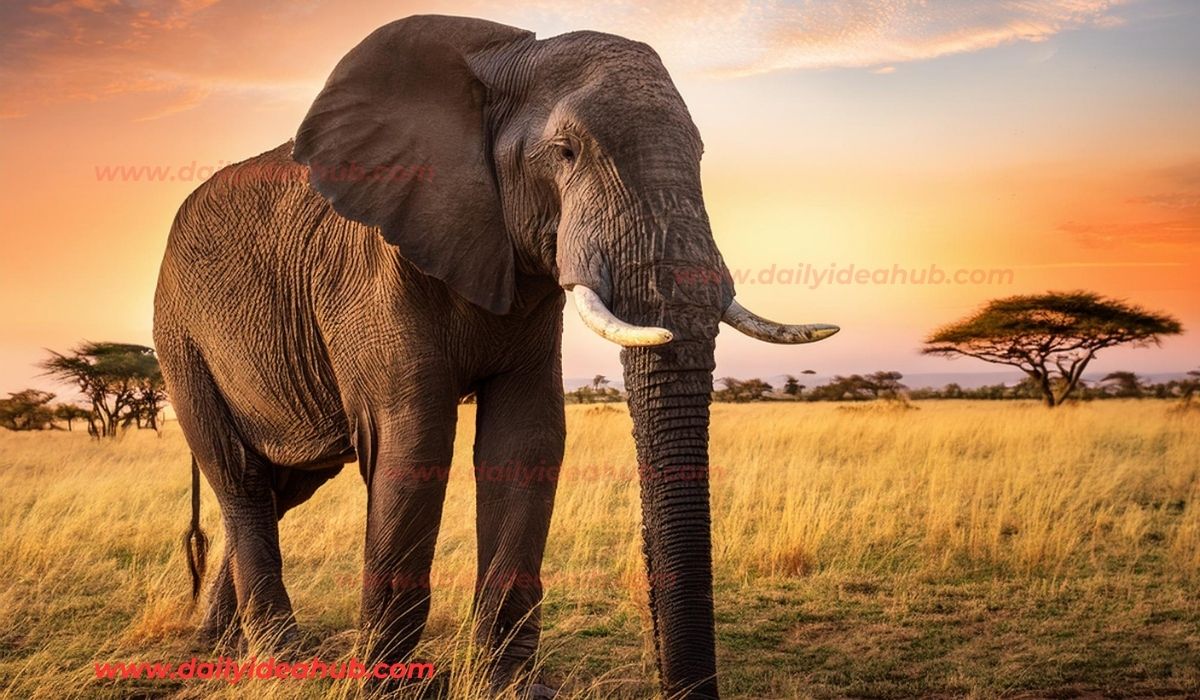
Elephants have always fascinated humanity with their sheer size, intelligence, and gentle nature. Among these magnificent creatures, Ahmed the Elephant stands out as one of the most renowned elephants in history. His life was more than just a tale of survival—it was a beacon of hope for conservation efforts and a symbol of the deep connection between humans and the natural world.
This article will delve into the life of Ahmed, his significance in wildlife conservation, his cultural impact, and the lasting legacy he left for future generations. We’ll explore why his story continues to inspire and why Ahmed remains a global icon of peace.
Table of Contents
Who Was Ahmed the Elephant?
The Life of Ahmed
Ahmed the Elephant was a massive African elephant known for his gentle spirit, extraordinary size, and breathtaking tusks. African elephants are already some of the most impressive land mammals, but Ahmed stood out not only because of his physical attributes but also because of his calm, peaceful demeanor. His presence captivated the people who encountered him, and his fame soon spread far beyond Africa.
Ahmed lived for an unusually long time, which allowed his legend to grow. His most distinctive feature was his large, curved tusks—among the largest ever recorded on an African elephant. These tusks made him a target for ivory hunters, but his story became one of protection rather than tragedy, thanks to conservation efforts.
Ahmed’s Global Recognition
Unlike many elephants whose stories remain untold, Ahmed the Elephant became a legend both in his native Africa and globally. As word of Ahmed’s magnificent tusks and calm nature spread, people from around the world became interested in this gentle giant. Travelers, scientists, and historians made journeys to see Ahmed, and soon his legacy crossed continents.
His fame was not merely a result of his size or beauty, but of the role he played in conservation efforts. Ahmed the Elephant became more than just an animal; he became a global symbol of the fight to protect endangered wildlife, especially elephants facing extinction due to poaching.
Ahmed the Elephant: Early Life and Discovery

Born in the African Wild
Ahmed was born on the vast African plains, where elephants have roamed for thousands of years. These majestic creatures thrive in the savannas of Africa, and Ahmed the Elephant was no exception. From a young age, he was known for his unique characteristics—most notably, his enormous tusks and unusually calm demeanor.
Growing up in the wild, Ahmed was a part of a large elephant herd that traveled across wide, open spaces in search of food and water. His early life was typical for an elephant in the African wilderness, but his sheer size and peaceful nature quickly set him apart from the others.
The First Sightings of Ahmed
Local villagers were among the first to realize that Ahmed was no ordinary elephant. His massive stature and grand tusks caught the attention of everyone who saw him. Soon, stories of Ahmed the Elephant began circulating, and people from different regions came to see him for themselves.
Unlike many wild animals, Ahmed was approachable and peaceful, allowing people to admire him from a distance without fear. This unique combination of beauty and calmness turned Ahmed into a living legend, one whose presence inspired awe and respect.
Ahmed the Elephant’s Role in Culture
Cultural Significance in Africa
In African culture, elephants have long been revered for their wisdom, memory, and strength. Elephants like Ahmed are often seen as symbols of royalty and are respected as guardians of the land. For the people who lived near Ahmed’s territory, he was more than just an animal—he was a living embodiment of the values and traditions they held dear.
Elephants are also considered spiritual creatures in many African cultures. Their ability to remember long distances and events, their family-oriented nature, and their gentle yet powerful presence make them symbols of intelligence and protection. Ahmed the Elephant was seen as a representation of these qualities, solidifying his place in the folklore of the region.
Ahmed’s Impact Beyond Africa
Although Ahmed was a cultural icon in Africa, his fame extended far beyond the continent. His story captivated people around the world, making him a global ambassador for elephants and wildlife conservation. Ahmed the Elephant was not only admired for his physical beauty but also for what he represented—a peaceful coexistence between humans and the natural world.
As more travelers and naturalists learned of Ahmed, his fame spread to Europe, Asia, and North America. Ahmed the Elephant became a figurehead for international conservation campaigns, inspiring people to take action to protect wildlife and preserve natural habitats.
Ahmed the Elephant and Wildlife Conservation
Ahmed’s Role in Conservation
As Ahmed the Elephant grew older, his status as a wildlife icon took on even greater importance. By the time Ahmed became famous, elephants across Africa were facing severe threats from poachers who sought to profit from their valuable ivory tusks. With his massive tusks, Ahmed was an obvious target. However, thanks to early conservation efforts, Ahmed was protected, and his story helped shine a spotlight on the need to protect all elephants.
Ahmed’s peaceful demeanor and majestic appearance made him an ideal symbol for conservation. His story raised awareness about the illegal ivory trade and the devastating impact it was having on Africa’s elephant population. By promoting the message of protecting elephants, Ahmed the Elephant became a cornerstone of conservation campaigns.
Protecting Ahmed from Poachers
The fight to protect Ahmed the Elephant was a collaborative effort. Conservationists, local governments, and wildlife organizations worked together to ensure Ahmed’s safety. Authorities knew that if poachers were to target Ahmed, his death would be a significant loss not just for wildlife but for the conservation movement as a whole.
Special laws were passed to protect Ahmed the Elephant, and efforts were made to monitor his movements closely. As a result, Ahmed lived a long and peaceful life, free from the threats that claimed the lives of so many other elephants. His survival was a victory for conservation, and his story continues to inspire efforts to protect endangered species today.
Ahmed the Elephant: A Peaceful Giant
The Gentle Nature of Ahmed
Elephants are known for their intelligence, empathy, and complex social structures. Ahmed the Elephant embodied these traits in every way. Despite his enormous size and strength, Ahmed was known for his gentle nature and peaceful demeanor. He rarely showed aggression and was often observed interacting calmly with both humans and animals.
This peaceful nature made Ahmed the Elephant a beloved figure among those who encountered him. His calmness in the face of potential threats, as well as his ability to coexist peacefully with other animals, made him a symbol of harmony in the wild.
Ahmed’s Role as a Symbol of Peace
As Ahmed the Elephant gained recognition, he became more than just a wildlife icon—he became a symbol of peace. His gentle behavior, even in the face of danger, resonated with people around the world. Conservation organizations and peace movements used Ahmed’s image to promote peaceful coexistence between humans and nature.
Ahmed’s story also became a powerful metaphor for the need to protect not just elephants, but all creatures that face threats from human activity. His peaceful legacy continues to inspire efforts to create a more harmonious relationship between humans and the environment.
Fascinating Facts About Ahmed the Elephant
Here are some unique facts about Ahmed the Elephant:
- Ahmed’s tusks were among the largest ever recorded on an African elephant, making him a prime target for ivory poachers.
- He lived a long life, largely due to the protection provided by conservationists and local governments.
- Ahmed was known for his unusually calm demeanor, even when interacting with humans.
- His story played a crucial role in raising global awareness about the illegal ivory trade.
- Ahmed’s image has been used in art and media as a symbol of wildlife conservation and peace.
The Enduring Legacy of Ahmed the Elephant
Ahmed’s Influence on Modern Conservation
The legacy of Ahmed the Elephant is still felt today. His life and the efforts made to protect him have become an important chapter in the history of wildlife conservation. His story has inspired numerous conservation campaigns and continues to be a symbol of the need to protect endangered species.
Today, elephants remain at risk from poaching and habitat destruction, but thanks to Ahmed the Elephant’s story, there is greater awareness and action being taken to save these magnificent creatures. Ahmed’s life serves as a reminder that with effort and collaboration, it is possible to protect wildlife and ensure their survival.
Ahmed’s Place in Art and Culture
The story of Ahmed the Elephant has also been immortalized in art, literature, and documentaries. Artists and filmmakers have used Ahmed’s image to raise awareness about the plight of elephants and the importance of conservation. His peaceful nature and extraordinary beauty continue to inspire creative works that celebrate the majesty of wildlife.
From paintings to sculptures, Ahmed the Elephant remains a beloved figure in the world of wildlife art. His legacy serves as a source of inspiration for artists and activists alike.
Table: Key Highlights of Ahmed the Elephant’s Life
| Aspect | Details |
|---|---|
| Species | African Elephant |
| Unique Feature | Exceptionally large tusks |
| Personality | Gentle, calm, peaceful |
| Conservation Impact | Major figure in anti-poaching and wildlife protection efforts |
| Global Fame | Recognized worldwide for his grace and beauty |
| Legacy | Continues to influence conservation campaigns |
Lessons from Ahmed the Elephant’s Story
The story of Ahmed the Elephant teaches us valuable lessons about the need to protect wildlife and live in harmony with nature. His life serves



